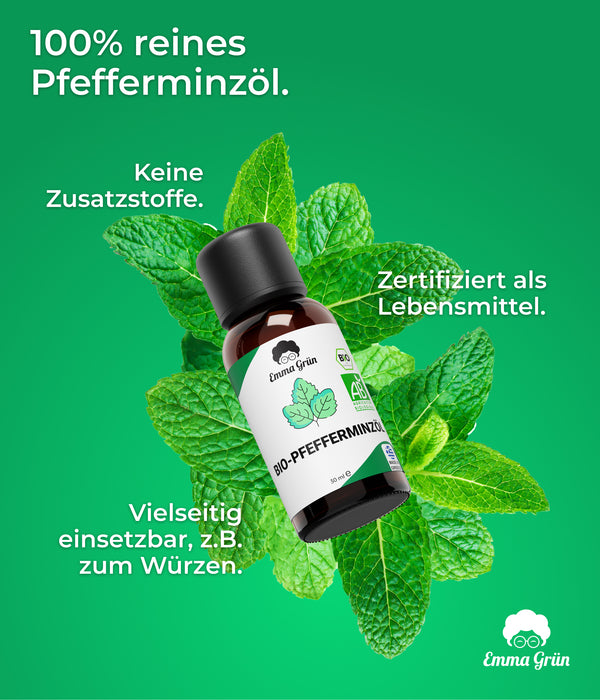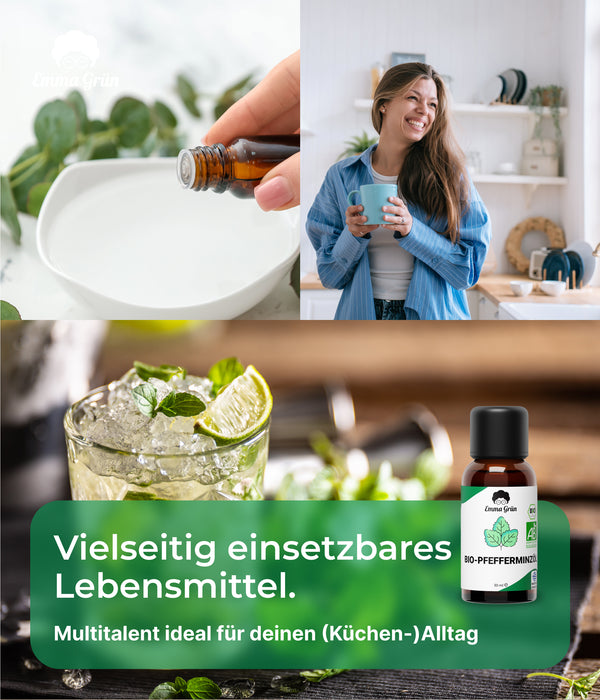Pfefferminze: Ein Geschenk der Natur mit vielen Vorzügen
Die Pfefferminze gehört zu jenen Pflanzen, die aufgrund ihres Aromas und ihrer vielseitigen Eigenschaften bei vielen Menschen einen hohen Stellenwert einnimmt. Auch in der Küche wird sie in vielen Kulturen hochgeschätzt. Denn mit ihrem erfrischenden Duft und Geschmack verleiht sie unzähligen Gerichten, Desserts und Getränken eine besondere Note. Von aromatischen Tees über würzige Soßen hin zu süßen Leckereien: Die Einsatzmöglichkeiten von Pfefferminze sind nahezu grenzenlos.
Doch was macht das Kraut so einzigartig und wie lässt es sich in der Küche nutzen? Genau dies möchten wir in den folgenden Zeilen klären. Obendrein erfährst du, wie man Pfefferminzöl selbst herstellen kann, wie sich frische Pfefferminze vom ätherischen Öl unterscheidet und worauf du beim Kauf hochwertiger Produkte achten solltest.
Pfefferminze: Merkmale
Pfefferminze ist ein wahres Wunder der Natur und zeichnet sich durch eine Vielzahl von faszinierenden Merkmalen und charakteristischen Eigenschaften aus.
- Aromatischer Duft und Geschmack: Pfefferminze verströmt ein erfrischendes, minziges Aroma, das unter Tausenden sofort erkennbar ist. Ihr Geschmack ist intensiv, kühlend und leicht süßlich, was sie rund um den Globus zu einer beliebten Zutat in der Küche macht.
- Dunkelgrüne Blätter: Die Blätter der Pfefferminze sind dunkelgrün, oval geformt und leicht gezahnt.
- Lila Blüten: Während der Blütezeit entwickelt die Pfefferminze kleine lila Blütenstände, die nicht nur hübsch anzusehen sind, sondern auch Bienen und andere Bestäuber anziehen.
- Robuste Wachstumsbedingungen: Pfefferminze ist eine robuste Pflanze, die in verschiedenen Klimazonen gedeiht. Sie bevorzugt sonnige bis halbschattige Standorte und gut durchlässige Böden.
- Schnelles Wachstum: Eines der bemerkenswertesten Merkmale der Pfefferminze ist ihr schnelles Wachstum. Sie breitet sich gerne aus und bildet unterirdische Ausläufer, wodurch ohne Eingriff des Menschen in kürzester Zeit ganze Pfefferminz-Gärten entstehen können.
Die erwähnten Merkmale machen Pfefferminze zu einem aromatischen Küchenkraut, welches einfach zu vermehren und obendrein schön anzusehen ist.
Pfefferminze: Wirkstoffe und Eigenschaften
Pfefferminze ist in der kulinarischen Welt weit mehr als nur ein Kraut, welches Getränken ein erfrischendes Aroma verleiht. Ihre einzigartigen, aktiven Wirkstoffe machen sie zu einem wahren Highlight in der Küche. An der Spitze steht das Menthol, bekannt für seinen kühlen, frischen Geschmack, der Gerichte und Getränke auf ein ganz neues Level hebt. Aber das ist längst nicht alles. Pfefferminze enthält auch Menthon, das für ein intensiveres Aroma sorgt, sowie Limonen, die mit einem zitrusartigen Unterton eine leichte und frische Note beisteuern.
Diese Kombination aus Wirkstoffen machen Pfefferminze zu einem vielseitigen Küchenkraut. Egal, ob du ein erfrischendes Sommergetränk zubereiten, eine würzige Soße verfeinern oder deinem Dessert eine besondere Note geben möchtest: Pfefferminze verleiht jedem Gericht und jedem Getränk ein einzigartiges Aroma. Denn ihre Wirkstoffe helfen dabei, die Geschmackspalette zu erweitern und sorgen für ein unvergessliches kulinarisches Erlebnis. So wird Pfefferminze zum unverzichtbaren Bestandteil kreativer Rezepte, die deine Küche bereichern.
Pfefferminzöl vs. frische Pfefferminze: Gemeinsamkeiten & Unterschiede
Pfefferminzöl und frische Pfefferminze sind zwei Varianten desselben erfrischenden Geschmacks, die in der Küche verwendet werden können. Sie haben einige Gemeinsamkeiten, aber auch wesentliche Unterschiede, die wir einmal genauer unter die Lupe genommen haben.
Gemeinsamkeiten:
- Minziges Aroma: Sowohl Pfefferminzöl als auch frische Pfefferminze verleihen Gerichten ein charakteristisches Aroma, das erfrischend und belebend ist.
- Kühlender Effekt: Beide Varianten haben einen kühlenden Effekt am Gaumen, der in Getränken, Desserts und Speisen geschätzt wird.
- Vielseitige Verwendung: Pfefferminzöl und frische Pfefferminze können in einer Vielzahl von Rezepten verwendet werden, um Geschmack und Aroma hinzuzufügen.
- Beliebtes Gewürzkraut: Sowohl Pfefferminzöl als auch frische Pfefferminze sind beliebte Zutaten in der kulinarischen Welt und werden gleichermaßen für süße und herzhafte Gerichte verwendet.
Unterschiede:
- Konzentration: Der größte Unterschied liegt in der Konzentration der Aromen. Pfefferminzöl ist äußerst konzentriert, da es durch Destillation gewonnen wird. Frische Pfefferminze hingegen ist weniger konzentriert und kann in größeren Mengen verwendet werden.
- Dosierung: Aufgrund der hohen Konzentration von Pfefferminzöl sollte es äußerst sparsam dosiert werden. Bereits ein Tropfen kann einen intensiven Geschmack erzeugen. Frische Pfefferminze erfordert in der Regel größere Mengen, um den gleichen Effekt zu erzielen.
- Anwendung: Pfefferminzöl eignet sich besonders gut zum Aromatisieren von Schokolade, Backwaren und Getränken. Frische Pfefferminze wird oft in Salaten, Soßen und Desserts verwendet, wo ihre Blätter zusätzlich dekorativen Zwecken dienen.
- Haltbarkeit: Pfefferminzöl hat eine längere Haltbarkeit als frische Pfefferminze. Es bleibt länger frisch und behält sein Aroma, während frische Pfefferminze schneller verdirbt.
Aufgrund des unterschiedlichen Aggregatzustandes eröffnen dir Pfefferminzöl und frische Pfefferminze verschiedene kulinarische Möglichkeiten. Daher hängt die Wahl von deinem speziellen kulinarischen Vorhaben und deinem persönlichen Geschmack ab.
Wie lässt sich Pfefferminzöl selber herstellen?
Die Herstellung von reinem Pfefferminzöl mithilfe von Wasserdampfdestillation ist ein faszinierender Prozess, der Geduld und Sorgfalt erfordert. Für den Hausgebrauch ist dieses Herstellungsverfahren in der Regel zu aufwendig und wird daher nur selten praktiziert.
Eine einfachere Methode für zu Hause ist die Kaltauszugs-Methode. Hierbei legst du die zerkleinerten Blätter in ein Trägeröl wie Olivenöl oder Mandelöl ein und lässt die Mischung für einige Wochen an einen dunklen, kühlen Ort ziehen. Während dieser Zeit geben die Pfefferminzblätter ihre ätherischen Öle an das jeweilige Trägeröl ab. Nachdem die Mischung ziehen konnte, wird das Öl gefiltert. Das Resultat ist ein aromatisches Pfefferminzöl, mit dem du diverse hausgemachte Kreationen und Salate verfeinern kannst.
Pfefferminzöl kaufen: Darauf solltest du achten
Möchtest du Pfefferminzöl kaufen und von seinem erfrischenden Aroma und den vielfältigen Anwendungsmöglichkeiten profitieren? Dann haben wir ein paar Tipps für dich, die du dir zu Herzen nehmen solltest.
1. Reinheit und Qualität: Stelle sicher, dass das Pfefferminzöl von hoher Reinheit und Qualität ist. Achte auf Bezeichnungen wie „100 % reines Pfefferminzöl“ oder „Lebensmittel zertifiziert“. Dies garantiert, dass das Öl keine Zusatzstoffe oder Verunreinigungen enthält.
2. Herkunft: Informiere dich über die Herkunft des Pfefferminzöls. Oft stammt hochwertiges Pfefferminzöl aus Ländern wie Griechenland, den USA, England oder Süddeutschland, wo die Pflanze unter optimalen Bedingungen angebaut wird.
3. Bio-Zertifizierung: Bio-Pfefferminzöl ist eine ausgezeichnete Wahl, da es ohne den Einsatz von Pestiziden oder chemischen Düngemitteln hergestellt wird. Suche nach dem Bio-Siegel auf dem Produkt.
4. Art der Pfefferminze: Es gibt verschiedene Sorten von Pfefferminze, darunter die klassische Grüne Minze und die Krausminze. Je nach Verwendungszweck und persönlichem Geschmack kannst du die passende Sorte wählen.
5. Kennzeichnung und Verpackung: Überprüfe die Kennzeichnung auf dem Produkt. Sie sollte Informationen zur Reinheit, Herkunft und Art der Pfefferminze enthalten. Das Öl sollte zudem in einer dunklen Glasflasche abgefüllt sein, um es vor Licht und Wärme zu schützen.
6. Preis: Hochwertiges Pfefferminzöl ist oft etwas teurer als 0815-Produkte. Am Ende des Tages lohnt es sich, in Qualität zu investieren. Denn nur bei einem reinen Bio-Produkt kannst du die hervorragenden Eigenschaften der Pflanze zu deinem Vorteil nutzen.
7. Kundenstimmen: Lies Kundenbewertungen und Erfahrungsberichte, um mehr über die Qualität des Pfefferminzöls eines bestimmten Herstellers zu erfahren. Dies kann dir helfen, eine fundierte Entscheidung zu treffen.
8. Verwendungszweck: Denke darüber nach, wofür du das Pfefferminzöl verwenden möchtest. Für den kulinarischen Gebrauch solltest du nach Ölen suchen, die als sicher für den Verzehr gekennzeichnet sind.
Wenn du beim Kauf auf Reinheit und Qualität achtest, kann Pfefferminzöl eine wunderbare Ergänzung für deine Küche sein. Möchtest du erfahren, wie du ätherisches Pfefferminzöl sonst noch nutzen kannst, dann solltest du es nicht verpassen, auf unserem Blog vorbeizuschauen. Denn Pfefferminzöl ist vielfältiger, als du vielleicht denkst.
Mit WordToHTML.net in HTML umgewandelt





















